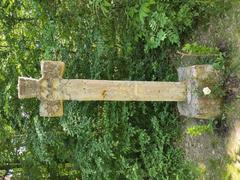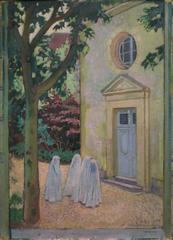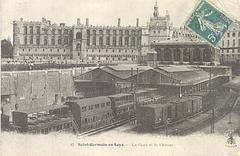Temple Protestant de Saint-Germain-en-Laye: Visiting Hours, Tickets, and Historical Significance
Date: 04/07/2025
Introduction
Nestled in the heart of Saint-Germain-en-Laye, France, the Temple Protestant de Saint-Germain-en-Laye stands as a remarkable testament to the enduring legacy of Protestantism in a region shaped by centuries of royal and religious history. Established in 1862, this neo-Gothic temple reflects both the simplicity of the Reformed tradition and a spirit of religious tolerance rooted in the city’s past. Today, it offers a vibrant community life and welcomes visitors with free entry, accessibility accommodations, and opportunities for guided exploration, making it an essential stop for anyone interested in French religious heritage.
Conveniently located at 1 avenue des Loges, the temple is just steps away from major attractions like the Château de Saint-Germain-en-Laye and the National Archaeology Museum, ensuring its place as a key destination in any cultural itinerary in the Île-de-France region. For up-to-date information about visiting hours and special events, consult the Saint-Germain-en-Laye Tourism Office and the Église protestante unie de France.
This comprehensive guide covers the temple’s historical roots, architectural features, visitor information, accessibility, nearby attractions, and travel tips.
Table of Contents
- Introduction
- Construction and Architectural Features
- Visiting Information: Hours, Tickets, and Accessibility
- Nearby Attractions and Travel Tips
- Restoration and Heritage Recognition
- Religious and Cultural Significance
- Community Life and Notable Events
- FAQ
- Conclusion
- Sources and Further Reading
Origins and Early Protestant Presence
The roots of Protestantism in Saint-Germain-en-Laye trace back to the 16th century. The city is notably the birthplace of Jeanne d’Albret, Queen of Navarre, a key figure in the French Reformation and mother of King Henri IV. Jeanne d’Albret is remembered for her advocacy of religious tolerance and was instrumental in the movement toward freedom of conscience in France.
During the French Wars of Religion, the Edict of Saint-Germain (1562) was signed here, granting Protestants limited rights to worship and marking an important moment in the progression of religious tolerance in France.
Protestant Community and Early Worship Spaces
Despite enduring centuries of religious tension, a Protestant community survived in Saint-Germain-en-Laye. Worship was often conducted discreetly in private homes or temporary chapels. By the 19th century, the community grew large enough to necessitate a dedicated place of worship. Before the current temple, services were held in a small chapel that also accommodated English-language worship, reflecting the cosmopolitan nature of the congregation.
Napoléon Peyrat, appointed as pastor in the mid-19th century, was instrumental in fostering goodwill between Protestants and Catholics, even supporting the restoration of the local Catholic church—a significant gesture of ecumenism at the time (Musée Protestant).
Construction and Architectural Features
Completed in 1862, the Temple Protestant de Saint-Germain-en-Laye is a fine example of neo-Gothic architecture, designed with a focus on simplicity and spiritual clarity, in line with Reformed church traditions (myCityHunt). The rectangular building features:
- Façade: A round-arched portal, twin-arched window, and a simple cross above the gable. The entrance is flanked by two small niches.
- Setting: The temple sits in a peaceful plot that includes a garden and parking area.
- Interior: The single-level nave is bathed in natural light, with minimal ornamentation. A marble plaque commemorates Jeanne d’Albret, and an organ on the mezzanine enhances the musical dimension of worship.
Neo-Gothic façade with round-arched portal and twin-arched window.
Visiting Information: Hours, Tickets, and Accessibility
- Hours: The temple is open to visitors primarily during worship services on Sundays at 10:30 am and 6:00 pm. For visits outside these times, check the official website or contact the parish for appointments or special events.
- Tickets: Entry is free for worship and casual visits. Some special events may require tickets or advance registration.
- Accessibility: The temple is wheelchair accessible, with a street-level entrance and no significant steps. Assistance is available upon request.
- Guided Tours: Guided tours are available during special occasions such as European Heritage Days and can be arranged for groups by contacting the parish office.
- Visitor Etiquette: Dress modestly, maintain respectful silence, and avoid photography during services unless permitted.
For further details on services and events, see the parish website.
Nearby Attractions and Travel Tips
Saint-Germain-en-Laye is rich in history and culture. Highlights include:
- Château de Saint-Germain-en-Laye: The former royal palace now houses the National Archaeology Museum (everycastle.com).
- Parc du Château: Gardens designed by André Le Nôtre, ideal for walks (triplyzer.com).
- Église Saint-Germain: Historic Catholic church with the tomb of King James II of England.
- Maison Debussy: Birthplace of the composer Claude Debussy (solosophie.com).
- Local cafés and markets: The town center is vibrant and welcoming.
Getting There: Saint-Germain-en-Laye is about 20 km west of Paris, easily accessible via RER A from central Paris stations. The temple is a short walk from the train station.
Travel Tips: Weekday mornings are quieter. Many locals speak English. Public transportation is recommended, but parking is available nearby.
Restoration and Heritage Recognition
Major restoration work in the 21st century, supported by the local municipality, has preserved the temple’s structure and appearance. In 2021, it was designated a “Patrimoine d’intérêt régional” (Heritage of Regional Interest), underscoring its importance in the Île-de-France region (JL Turbet’s blog).
Religious and Cultural Significance
The temple is not only a place of worship but also a living symbol of the resilience of Protestant communities in France. As part of the Église protestante unie de France, it hosts regular services, cultural events, and interfaith initiatives, continuing its historic role in fostering dialogue and understanding.
Community Life and Notable Events
Throughout its history, the temple has been a hub for worship, education, and civic engagement. It is involved in citywide events like the European Heritage Days, open days on laïcité (secularism), and commemorates its past leaders with marble plaques. The community remains active in charity and cultural projects, reflecting the temple’s ongoing relevance.
Frequently Asked Questions (FAQ)
Q: What are the visiting hours?
A: The temple is open for worship on Sundays at 10:30 am and 6:00 pm. For other visits, check the official website or contact the parish.
Q: Is there an entry fee?
A: No, entry is free. Some special events may require tickets.
Q: Is the temple accessible?
A: Yes, it is wheelchair accessible. Contact the parish for assistance if needed.
Q: Are guided tours available?
A: Yes, during special events or by arrangement.
Q: Can I take photographs?
A: Photography is allowed outside service times and with permission.
Conclusion
The Temple Protestant de Saint-Germain-en-Laye is a living monument to religious tolerance, architectural elegance, and community spirit. Its rich history, tranquil setting, and welcoming atmosphere make it a rewarding destination for visitors interested in the intersection of faith, culture, and history. Plan your visit to explore this unique facet of French heritage and enjoy the vibrant surroundings of Saint-Germain-en-Laye.
For the latest updates, special events, and travel tips, visit the official temple website and the Saint-Germain-en-Laye Tourism Office.
Sources and Further Reading
- Saint-Germain-en-Laye Tourism Office
- Temple de Saint-Germain-en-Laye on myCityHunt
- Napoléon Peyrat, Musée Protestant
- Église Protestante Unie de Saint Germain en Laye official site
- JL Turbet’s blog
- HoraireDeMesse.fr
- Le Parisien
- Journées du Patrimoine
- Audiala
- everycastle.com
- triplyzer.com
- solosophie.com




